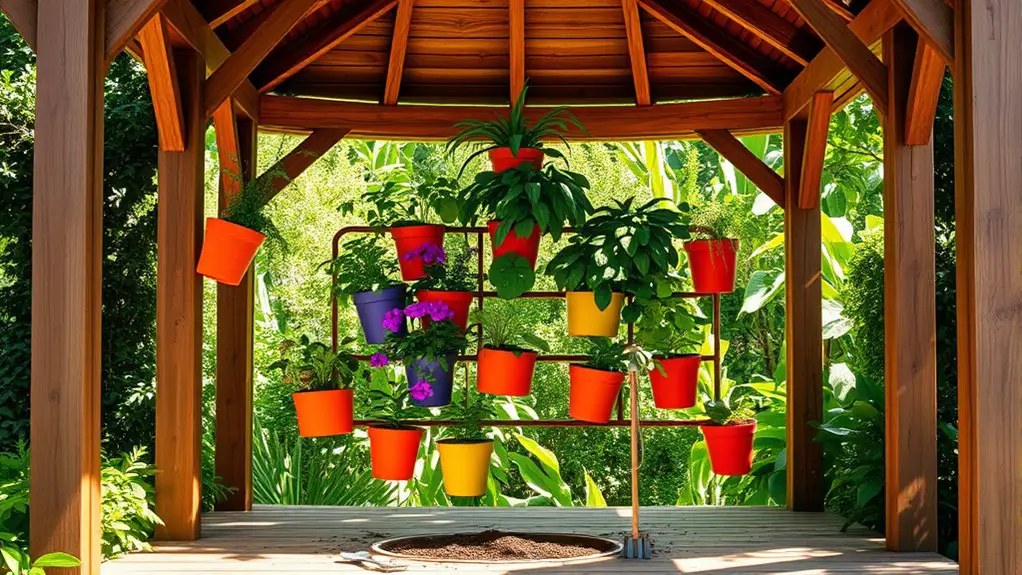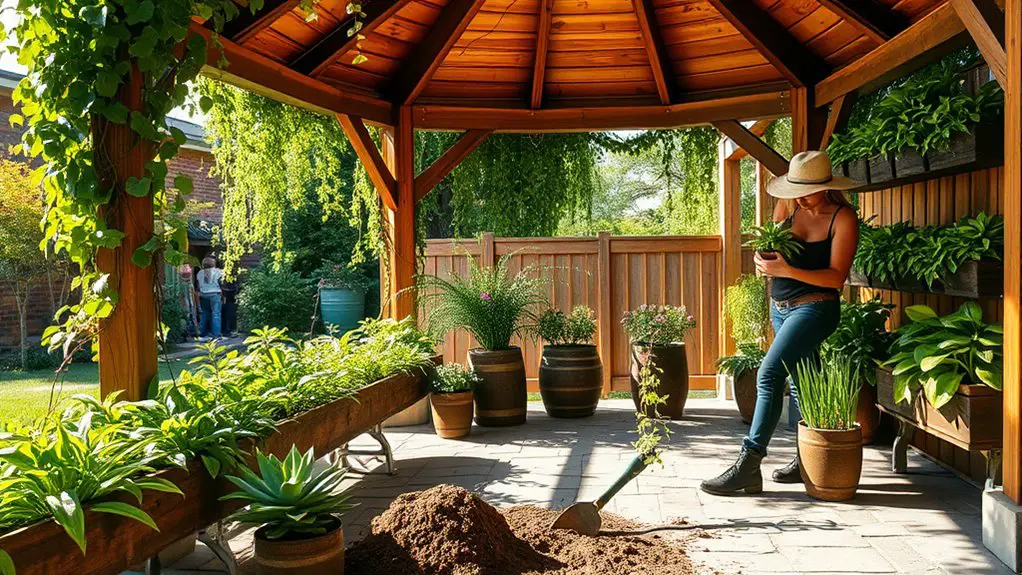To set up a vertical garden in your gazebo, start by choosing a sunny location with good airflow and easy access. Prepare the structure by checking for stability and reinforcing weak points. Select climbing plants like sweet peas and climbing roses, and design a vertical system using weather-resistant panels or trellises. Properly mix your soil for drainage and nutrient retention, and establish a consistent watering routine to maintain plant health. More detailed steps await you to guarantee a thriving garden.
Choosing the Right Location for Your Vertical Garden

When selecting a location for your vertical garden in a gazebo, it’s crucial to take into account factors such as sunlight exposure, wind exposure, and accessibility. Ideally, you want a spot that receives at least six hours of direct sunlight daily. This guarantees your plants can photosynthesize effectively, promoting healthy growth.
Additionally, consider air circulation. Proper airflow helps prevent diseases and pests that thrive in stagnant conditions. Position your garden in a way that maximizes natural breezes but also offers some protection against harsh winds that can damage delicate plants.
Accessibility is equally important; make sure you can easily reach your vertical garden for maintenance tasks like watering and pruning. A well-placed garden not only thrives but also enhances your gazebo experience, allowing you to enjoy a beautiful, lush environment without compromising your freedom to move and interact comfortably.
Selecting the Best Plants for Vertical Growth
Selecting the right plants for vertical growth is essential if you want your garden to thrive and create an eye-catching display. Focus on climbing plants that can effectively utilize vertical planters, maximizing your space while enhancing aesthetics. Climbing plants provide natural shade and privacy, making them ideal for your gazebo.
Here’s a table to help you choose the best options for your gazebo:
| Plant Name | Growth Rate | Sunlight Requirement |
|---|---|---|
| Sweet Peas | Fast | Full Sun |
| Climbing Roses | Moderate | Full Sun |
| English Ivy | Fast | Partial Shade |
| Morning Glory | Fast | Full Sun |
| Hops | Moderate | Full Sun |
These climbing plants not only grow vertically but also add texture and color to your garden. Make sure to take into account the sunlight and space available, ensuring your vertical garden flourishes beautifully.
Designing Your Vertical Garden Structure

A well-structured vertical garden can transform your gazebo into a stunning focal point, and there are several key elements to contemplate in its design. First, consider the vertical design of your structure. You can use modular panels, trellises, or wall-mounted pockets to create a multi-layered look that enhances garden aesthetics. Make certain your materials are weather-resistant, like treated wood or metal, to withstand the outdoor elements.
Next, think about the layout. A staggered arrangement of plants will not only maximize space but also create visual interest. Incorporate a drip irrigation system to maintain moisture efficiently, allowing for healthy growth without constant upkeep.
Lastly, consider the color and texture of your plants to create harmony. Choose a variety of foliage sizes and shapes to add depth. By focusing on these elements, you’ll set the stage for a vibrant and functional vertical garden that complements your gazebo beautifully.
Preparing the Gazebo for Plant Installation
Before installing your vertical garden, you need to assess the structural integrity of your gazebo to guarantee it can support the added weight of the plants and soil. Check for any signs of damage or wear, and reinforce any weak areas as necessary. Additionally, choose a suitable location within the gazebo that provides adequate sunlight and ventilation for ideal plant growth.
Assess Structural Integrity
As you prepare to transform your gazebo into a lush vertical garden, evaluating its structural integrity is essential to guarantee it can support the added weight and moisture from your plants. Begin with a thorough structural assessment, examining the joints, beams, and overall frame for signs of wear or damage. Check that the materials used are durable enough to withstand both the weight distribution of your vertical garden and the increased humidity. Reinforce any weak points, ensuring the gazebo’s foundation is stable and secure. Consider additional bracing if needed. Doing so will provide the necessary support for your garden, allowing you the freedom to cultivate your green oasis without concern for structural failure. Your gazebo should be a sanctuary, not a risk.
Choose Suitable Location
Choosing the right location for your vertical garden within the gazebo is essential to secure ideal growth and health of your plants. First, assess sunlight exposure; most plants thrive with at least six hours of direct sunlight daily. Position your vertical garden where it can soak up this light without obstruction. Next, consider wind protection; excessive wind can damage delicate plants and dry them out. If your gazebo has walls or other structures, place the garden against these to shield it from harsh gusts. Additionally, make sure the location allows for easy access to water and maintenance. A well-thought-out position will not only enhance your garden’s aesthetics but also promote an environment where your plants can flourish freely.
Assembling the Vertical Garden System

Once you’ve gathered all the necessary materials for your vertical garden, assembling the system becomes a straightforward process. Start by laying out your vertical garden systems, guaranteeing you have the frame, planting containers, and support structures ready. Use assembly tips such as pre-drilling holes for screws to simplify installation and enhance stability. Attach the frame securely to the gazebo wall or structure, making sure it’s level for ideal water drainage.
Next, position the planting containers within the frame, aligning them according to your design. If your system incorporates irrigation, connect the tubing now, ensuring it’s properly sealed to prevent leaks. Once the containers are secured, fill them with your chosen growing medium. Finally, double-check all connections and guarantee that your system is firmly in place. With these steps, you’ll have a robust vertical garden ready to flourish, providing beauty and fresh produce right in your gazebo.
Soil and Fertilizer Considerations
Choosing the right soil type is vital for your vertical garden’s success, as it affects drainage, aeration, and nutrient retention. You’ll also need to implement effective fertilizer application techniques to guarantee your plants receive the essential nutrients they require for ideal growth. Understanding these components will enhance the health and productivity of your garden.
Soil Type Selection
Selecting the right soil type is essential for the success of a vertical garden in your gazebo. The soil composition directly impacts your plants’ health and growth. Here are four key considerations for soil selection:
- Texture: Aim for a mix of sandy, loamy, and clay soils to guarantee balanced moisture retention.
- Drainage Requirements: Choose soil that drains well to prevent root rot, especially in vertical setups.
- pH Level: Test the soil’s pH; most plants thrive in slightly acidic to neutral conditions (6.0 to 7.0).
- Nutrient Content: Consider using a soil mix enriched with organic matter to support healthy plant development.
Fertilizer Application Techniques
Applying fertilizer effectively is essential for enhancing the growth and health of your vertical garden. You should choose from various fertilizer types, including granular, liquid, and slow-release options, each offering distinct benefits. Granular fertilizers provide a steady nutrient supply, while liquid fertilizers allow for quick absorption. When it comes to application methods, consider using foliar feeding for immediate nutrient access or soil drenching for a deeper root impact. Make sure to follow the manufacturer’s guidelines regarding dosage and frequency to prevent nutrient burn. Additionally, monitor your plants’ response; adjust your fertilizer approach based on their growth patterns. A balanced fertilization strategy will empower your garden to flourish, giving you the freedom to cultivate a thriving green space.
Watering and Maintenance Tips
While maintaining a vertical garden in your gazebo, it’s important to establish a consistent watering routine to guarantee healthy plant growth. Implementing a drip irrigation system can ensure your plants receive the right amount of moisture while minimizing water waste. Here are some key tips to keep in mind:
- Set a Maintenance Schedule: Create a weekly plan to check moisture levels and adjust watering frequency as needed.
- Monitor Plant Health: Observe your plants for signs of over- or under-watering, like yellowing leaves or wilting.
- Adjust for Weather Changes: Increase watering during hot spells and decrease during cooler, wetter months.
- Clean the Drip Irrigation System: Regularly inspect and clean the drip lines to prevent clogs and maintain efficient water delivery.
Incorporating Lighting for Optimal Growth
To guarantee your vertical garden thrives, incorporating the right lighting is just as important as maintaining a consistent watering routine. Start by evaluating the light types available, such as LED, fluorescent, and incandescent, each offering unique benefits. LEDs are energy-efficient and can be tailored to emit specific wavelengths, optimizing the growth spectrum for your plants.
Position your lights to guarantee they cover all levels of your vertical setup, minimizing shadows and allowing even light distribution. For leafy greens, focus on blue light, while fruiting plants benefit from increased red light exposure.
Consider using a timer to mimic natural sunlight cycles, promoting robust growth while conserving energy. By strategically integrating lighting into your gazebo, you’re not just enhancing plant health; you’re empowering your vertical garden to reach its full potential. Prioritize this essential element, and watch your garden flourish.
Enhancing Aesthetics With Decorative Elements
Aesthetics play an essential role in transforming your gazebo into a stunning vertical garden space. By incorporating decorative elements, you can elevate the overall visual appeal and create a harmonious atmosphere. Here are some ideas to enhance your gazebo’s aesthetics:
- Decorative Planters: Choose unique, colorful planters that complement your plants and add flair.
- Vertical Art: Integrate artwork like metal sculptures or wall hangings that resonate with your garden theme.
- Natural Textures: Use materials like bamboo or reclaimed wood to create a rustic feel that blends with nature.
- Seasonal Accents: Update your decor with seasonal items—think pumpkins in fall or lanterns in summer—to keep the space dynamic. Incorporating lighting options can further enhance the ambiance of your vertical garden.
These decorative elements not only beautify your vertical garden but also express your personal style, making your gazebo a true reflection of freedom and creativity.
Frequently Asked Questions
How Much Sunlight Does a Gazebo Typically Receive?
If your gazebo faces south, it’ll likely receive ample sunlight exposure throughout the day. However, a north-facing gazebo may only get limited light. Consider your gazebo’s orientation to optimize sunlight for any plants you grow.
Can I Use Edible Plants in My Vertical Garden?
You can grow various edible plant options, like herbs and leafy greens, in your vertical garden. These plants not only provide fresh ingredients but also enhance aesthetics and maximize space, offering numerous vertical garden benefits.
What Tools Do I Need for Vertical Garden Installation?
For successful garden installation, you’ll need tool essentials like a level, measuring tape, drill, screws, soil knife, and watering can. These tools guarantee precision and efficiency, giving you the freedom to create your ideal vertical garden.
How Do I Prevent Pests in My Vertical Garden?
To prevent pests in your vertical garden, employ organic methods like introducing beneficial insects, using neem oil, and maintaining healthy soil. Regular monitoring and proper sanitation are also essential for effective pest control and plant health.
Is It Possible to Move the Vertical Garden Once Installed?
They say, “A rolling stone gathers no moss.” If you’re considering relocation, guarantee your vertical garden’s stability isn’t compromised. Assess weight, support structures, and root systems to facilitate a smooth, successful move without damaging your plants.

